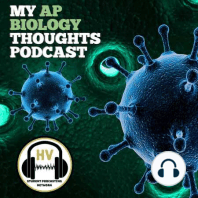11 min listen
Symbiotic Relationships
ratings:
Length:
6 minutes
Released:
Feb 15, 2021
Format:
Podcast episode
Description
My AP Biology ThoughtsUnit 8 Episode #29Welcome to My AP Biology Thoughts podcast, my name is Nikki and I am your host for episode #29 called Unit 8 Ecology: Symbiotic Relationships.. Today we will be discussing the 3 symbiotic relationships in nature.Segment 1: Introduction to symbiotic relationshipsSymbiosis is any type of a close and long-term biological interaction between two different biological organisms, be it mutualistic, commensalistic, or parasitic. The organisms, each termed a symbiont, may be of the same or of different speciesSegment 2: Example of symbiotic relationshipsMutualism: 2 organisms benefit from one anotherExample: oxpecker (a kind of bird) and the rhinoceros or zebra. Oxpeckers land on rhinos or zebras and eat ticks and other parasites that live on their skin. The oxpeckers get food and the beasts get pest control. Commensalism: 1 organism benefits and other organism is not impactedExample :Remora fish have a disk on their heads that makes them able to attach to larger animals, such as sharks, mantas, and whales. When the larger animal feeds, the remora detaches itself to eat the extra food.Parasitism: 1 organism benefits and the other is negatively impactedExample: Moose and ticks-In such numbers the ticks drain so much blood that the host moose can become anemic and malnourished Segment 3: Digging Deeper into symbiotic relationshipsHow does this topic fit into the greater picture of ecology?Ecology is all about organisms relationships with each other and the environmentHelps classify how they all fit in with each otherbecause they are a major driving force of evolution- coevolution-evolve together. This networking and cooperation among species allows them to survive better than they would as individuals.Thank you for listening to this episode of My AP Biology Thoughts. For more student-ran podcasts and digital content, make sure that you visit www.hvspn.com. See you next time!Music Credits:"Ice Flow" Kevin MacLeod (incompetech.com)Licensed under Creative Commons: By Attribution 4.0 License http://creativecommons.org/licenses/by/4.0/Subscribe to our PodcastApple PodcastsSpotifyGoogle Podcasts Stitcher YouTube Connect with us on...
Released:
Feb 15, 2021
Format:
Podcast episode
Titles in the series (100)
Darwin’s Early Life by My AP Biology Thoughts
